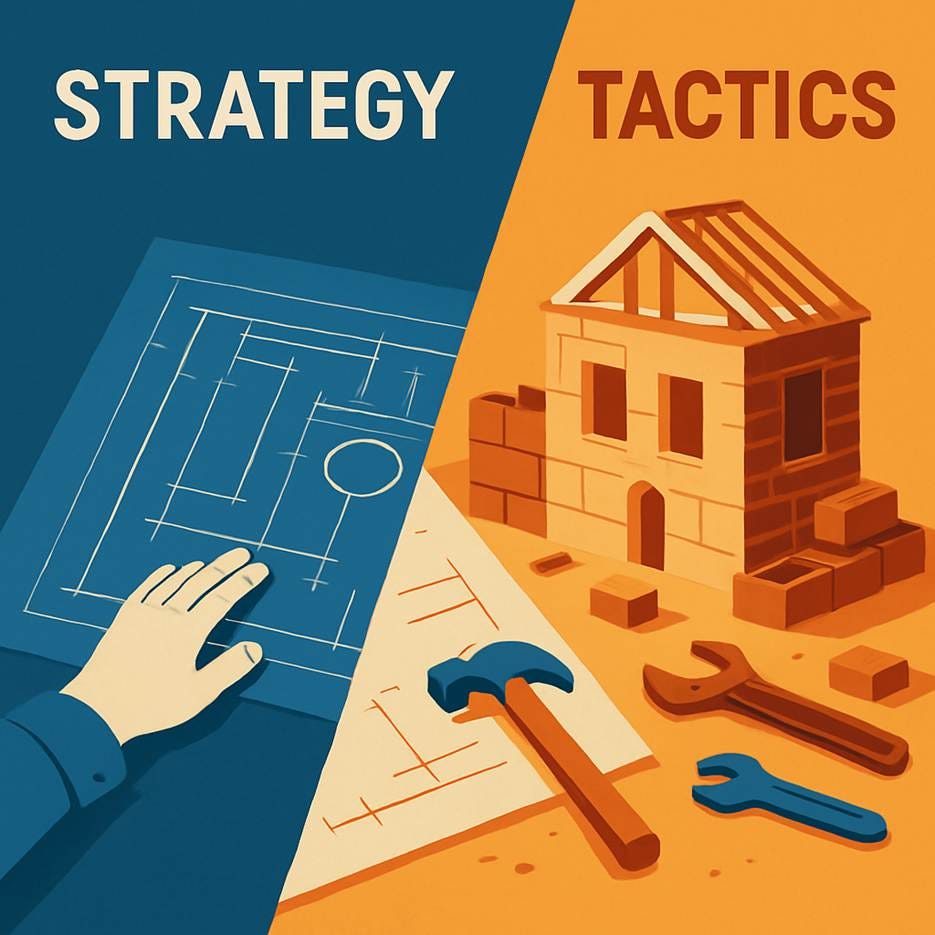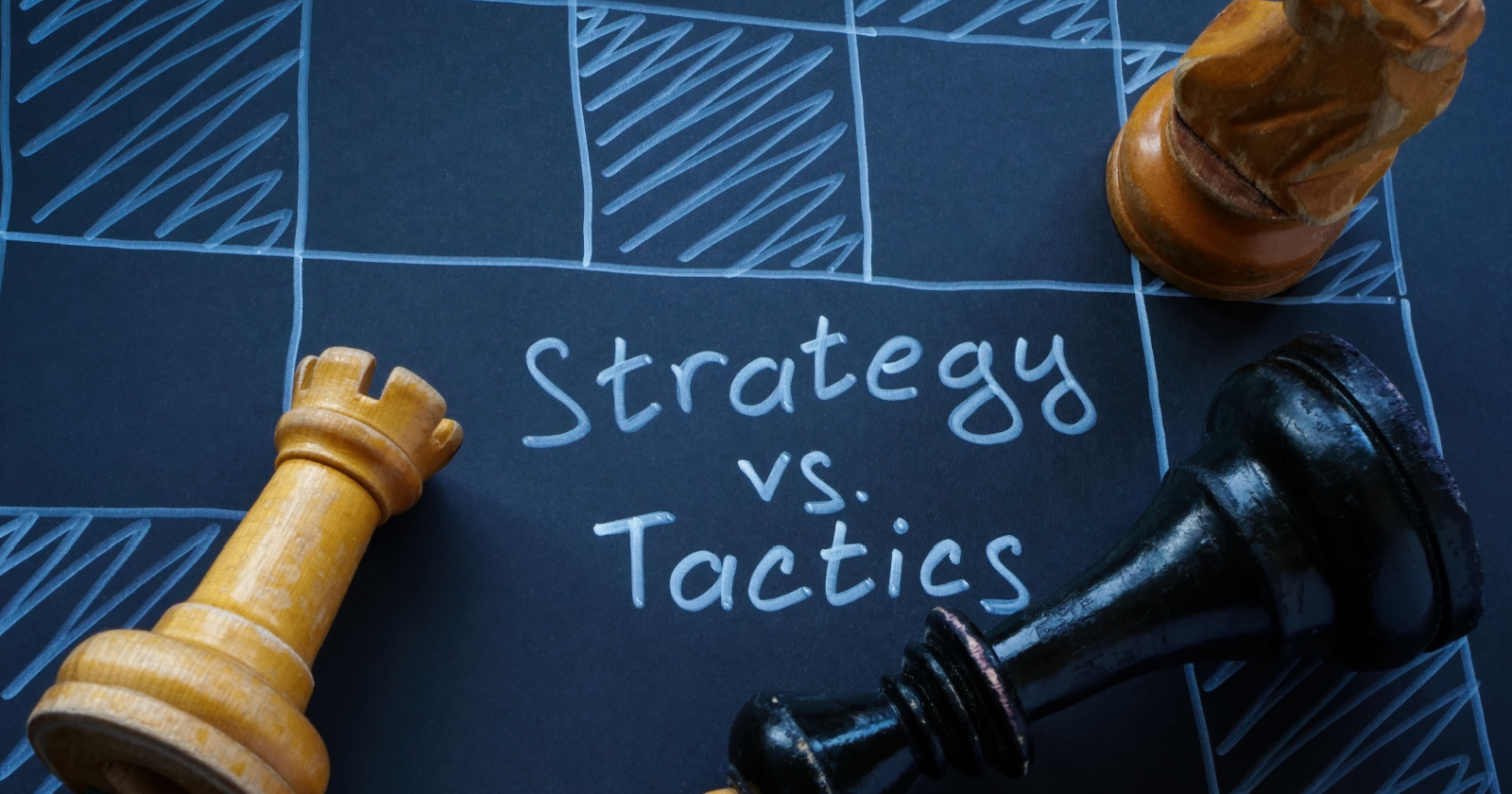For as long as I’ve been in this industry, there’s been debate about whether SEO is strategic or tactical. Most SEOs would like to believe their work is strategic. Many executives see it as tactical. The truth is somewhere in between, and the arrival of generative AI is forcing a new level of clarity.
This matters because “strategy” and “tactics” are not synonyms. In business, strategy is the plan. Tactics are the moves. Confusing the two doesn’t just muddy language. It leads to wasted resources, stalled initiatives, and misplaced expectations for what SEO can and cannot deliver.
Defining Strategy Vs. Tactics

Business literature has been clear on this for decades, and voices like Porter, Mintzberg, and Drucker shaped how leaders everywhere talk about strategy. Their framing applies directly when we examine SEO’s role today.
Michael Porter is widely recognized as the father of modern competitive strategy. A professor at Harvard Business School, he framed strategy as “choosing to run a different race, because it’s the one you’ve set yourself up to win.” His book “Competitive Strategy” remains one of the foundational texts in business thinking (his book on Amazon – not an affiliate link).
Henry Mintzberg is one of the most cited academics in management and organizational theory. He is famous for noting, “Strategy is not the consequence of planning, but the opposite: its starting point.” He also developed the 5 Ps framework — Plan, Ploy, Pattern, Position, and Perspective — which captures strategy as both deliberate and emergent (Mintzberg’s “The Strategy Concept I: Five Ps for Strategy”).
Peter Drucker is often called the father of modern management. His work shaped how companies think about leadership and decision-making. He emphasized that “the task of leadership is to create an alignment of strengths so strong that it makes the system’s weaknesses irrelevant.” His book “The Practice of Management” is considered a landmark in defining management’s role in aligning strategy with organizational outcomes (Drucker biography at the Drucker Institute).
Tactics, by contrast, are the practical steps. They’re what frontline teams execute, usually with short-term horizons. A strategy might be to compete on customer trust instead of low prices. The tactics are testimonial campaigns, return policies, and training staff to deliver exceptional service.
Other business functions get this distinction. In sales, strategy is deciding to prioritize enterprise accounts. Tactics are outreach sequences and demo scripts. In PR, strategy is positioning the brand as an industry leader. Tactics are pitching journalists and writing press releases. SEO is no different.
The confusion comes because SEO often has to “do it all.” Practitioners are expected to identify opportunities, set priorities, and then execute the work. That’s where the labels blur.
Strategy And Tactics In Traditional SEO
Looking back at the history of SEO makes the divide easier to see.
- Early 2000s, PageRank era: Strategy was simple. Invest in being discoverable on Google. Tactics included link building, directory submissions, and keyword-stuffed pages. Companies that treated SEO purely tactically often succeeded short-term but collapsed when penalties arrived. The strategy was clear. Pursue visibility on Google, while the tactics were the link farms, keyword stuffing, and directory submissions that executed it.
- 2010–2015, Panda and Penguin: Google cracked down on low-quality content and manipulative links. Strategy shifted to “quality and sustainability.” Tactics became pruning thin content, disavowing bad links, and investing in editorial teams. Content farms like Demand Media scaled on tactics, but lacked sustainable strategy, and they were decimated by Panda. Here again, leadership set the strategic shift toward quality, and SEO carried it out through content pruning and link cleanup.
- 2015–2020, Mobile and Core Web Vitals: Strategy was “meet users where they are.” They were on mobile and wanted fast experiences. Tactics were responsive design, structured data, and site speed audits. Companies that made this strategic shift early (e.g., news outlets investing in AMP) gained advantage. The strategic goal was serving users where they were, while SEO implemented the tactical fixes that delivered on it.
- 2020s, BERT and passage indexing: Strategy tilted toward semantic relevance, competing not just on keywords but on meaning and intent. Tactics were writing for topics, structuring content for passage-level retrieval, and emphasizing context. Strategy tilted toward meaning; tactics followed in the form of topic clusters and passage-level optimization.
At every stage, leadership set the strategy (“we need growth from search”), and SEO executed the tactics. Advanced SEOs sometimes influenced strategy by warning about risks or opportunities, but the bulk of work remained tactical.
Strategy And Tactics In GenAI Optimization
Generative AI reshapes the landscape. Instead of 10 blue links, users now get synthesized answers. That changes both the strategic questions and the tactical execution.
Strategic choices now include:
- Deciding whether to compete for visibility across multiple AI engines (ChatGPT, Perplexity, Gemini, Claude, etc.).
- Prioritizing authority signals so your brand is cited in machine answers.
- Choosing where to allocate budget: competing for evergreen visibility in broad topics, or dominating narrow niches where AI coverage is weaker.
- Determining how much to invest in retrievability testing and monitoring as an organizational function.
Tactical execution now includes:
- Structuring content into retrievable chunks sized for vector search.
- Running retrieval tests across platforms to measure exposure.
- Optimizing semantic density so each chunk is information-rich and self-contained.
- Adding schema and structured data to clarify entities and facts.
- Tracking machine-validated authority by measuring whether your content is surfaced or cited in AI responses.
- Query fan-out work to determine opportunities and identify semantic overlap.
These tactics look new, but they build directly on the foundation of traditional SEO. Schema is simply structured markup, refined. Semantic density is the next evolution of topical relevance. Retrieval tests are the modern equivalent of checking indexation. GenAI optimization doesn’t replace SEO; it evolves from it.
GenAI Optimization: Is It A Strategy Or Tactic?
The sudden surge of interest in “GenAI optimization” is a perfect case study in this strategy-versus-tactics debate.
Everyone is talking about chunking, embeddings, and retrievability as if they are strategy. They aren’t. They’re tactics. And treating tactics as strategy is a classic oversimplification, something the industry has been guilty of for decades.
- At the strategic level: Businesses decide that GenAI visibility is essential. They commit budget to becoming retrievable and authoritative across AI systems. They set goals to be cited in machine answers for their core vertical.
- At the tactical level: Teams restructure content into chunks, add schema, run retrieval probes in ChatGPT or Perplexity, and measure citation frequency.
Both layers are needed. The risk comes when companies mistake tactical execution for strategy.
The Cost Of Misalignment
When strategy and tactics are misaligned, businesses lose, and the losses are measurable.
- Missed opportunities: If leadership hasn’t set a strategy for GenAI visibility, tactical work is scattershot. Teams optimize content but don’t know which queries, topics, or surfaces matter. Competitors with clearer strategies win the ground.
- Lost revenue: Without strategy, companies may secure citations in AI answers that don’t align with customer value. The result is visibility without conversion.
- Wasted budgets: Chasing every GenAI trend without a clear North Star leads to investment in tools and audits that deliver no meaningful ROI.
- Eroded trust: When executives believe they’ve funded a strategy but only see tactical outputs, confidence in SEO teams drops. Leadership expected market impact and the team only delivered structural updates.
The lesson is blunt: Businesses don’t usually fail because tactics are poorly executed. They usually fail because tactics aren’t anchored in strategy.
Why SEO Has Been Seen As Tactical
For two decades, SEO has been defined by tactical output. Executives set the strategy (“We need organic growth”), and SEO was tasked with delivering through audits, fixes, optimizations, and publishing.
This framing wasn’t wrong as it reflected the organizational structure. Strategy was set higher up; SEOs carried it out. That’s why SEO often struggled to win budget or a seat in strategic planning meetings. It was seen as execution.
The AI-Driven Shift
Generative AI changes that equation. Machines are absorbing tactical SEO tasks. Today, AI tools can generate meta descriptions, suggest keywords, build internal linking recommendations, even create structured schema markup. Some platforms simulate retrieval patterns directly. What once required specialized SEO execution is increasingly automated.
That doesn’t eliminate SEO. It elevates it. If tactical execution is becoming commoditized, the value shifts to strategy.
This mirrors Microsoft’s research on AI’s occupational impacts, which distinguishes between user goals (strategic intent) and AI actions (tactical execution). Humans set the “why.” AI delivers the “how.”
For SEO, the same shift is underway. The tactical layer is being automated. The strategic opportunity is to lead on visibility, authority, and trust in AI-driven ecosystems.
Drawing The Line With Examples
- Traditional SEO in financial services: The strategy is to dominate “retirement planning for millennials.” The tactics include create calculators, publish evergreen guides, optimize metadata, and build relevant backlinks.
- GenAI optimization in sustainable investing: The strategy is to ensure the brand is a trusted citation in AI answers on ESG funds. The tactics include run retrieval checks in Perplexity, embed structured citations, optimize chunks for semantic clarity, and measure citation frequency in ChatGPT and Gemini.
One sets the direction. The other executes the playbook.
Why This Feels Touchy
Many SEOs call their work strategic because they connect content, technical architecture, and authority signals into a broader picture. In many organizations, they’re the only ones framing visibility at all, but that doesn’t make every action strategic.
That deserves credit. But precision matters. Running an audit is not strategy. Updating a robots.txt file is not strategy. These are tactical actions. If we blur the line, we diminish our influence at precisely the moment AI is eroding the value of tactics.
Where The Balance Lies
So, is SEO strategic or tactical? The honest answer is both, but not equally.
- Historically, SEO has been tactical.
- Today, SEO carries strategic implications, especially as AI reshapes discovery.
- The opportunity is to make the leap: from executing optimizations to shaping how organizations appear in machine-driven answers.
The balance is this: Tactics still matter. You can’t ignore schema, chunking, or retrieval testing. But the differentiator is strategy: deciding which battles to fight, which surfaces to win, and how to align SEO with the company’s long-term positioning.
Why This Matters For SEOs
This isn’t a semantic debate. It’s about influence and survival.
- If SEO is seen as tactical, it’s underfunded, siloed, and brought in too late.
- If SEO is seen as strategic, it gets budget, resources, and a seat in the boardroom.
The GenAI shift creates a once-in-a-generation opening for SEOs to redefine their value. As AI absorbs more tactical execution, the real opportunity is for SEOs to align with company-level strategy and expand their scope into visibility, trust, and authority. Those who recognize the difference between strategy and tactics will step into leadership. Those who stay focused only on tactical execution risk being automated out.
Closing Thought
For 20 years, SEO has been tactical excellence in service of growth. With GenAI, the tactical layer is shifting to machines. That makes strategy the defining frontier.
Not because SEOs suddenly became strategists, but because the environment demands it. The question now is: will SEOs step into that role, or will someone else claim it?
More Resources:
- Semantic Overlap Vs. Density: Finding The Balance That Wins Retrieval
- 10 Strategic SEO Insights & Tactical Advice For 2025 And Beyond
- SEO In The Age Of AI
This post was originally published on Duane Forrester Decodes.
Featured Image: Vitalii Vodolazskyi/Shutterstock


